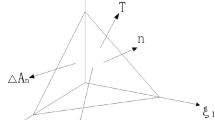Abstract
Experiments on the explosive welding of low-plasticity steels through thin plastic layers show that, aside from the geometric features of collision (thickness and angle of collision of plates and contact point velocity), the sizes of waves arising in the weld are also highly affected by the mechanical properties of welded materials (hardness, density, and sound velocity). It is determined that waves of different sizes can be formed under the same conditions, but their length lies in a certain range of values. On the basis of the experimental data obtained and with involvement of the Landau model, which describes the instability of a steady flow of viscous fluid, expressions for estimating the upper and lower wavelength limits are constructed with account for both geometric parameters of collision and mechanical properties of colliding metal plates.
Similar content being viewed by others
References
B. S. Zlobin, V. V. Kiselev, A. A. Shterzer, and A. V. Plastinin, “Use of Emulsion Explosives in Experimental Studies of Flows in the Bonding Zone in Explosive Welding,” Fiz. Goreniya Vzryva 54 (2), 114–121 (2018) [Combust., Expl., Shock Waves 54 (2), 231–237 (2018)]; DOI: 10.15372/FGV20180212.
W. A. Allen, J. M. Mapes, and W. G. Wilson, “An Effect Produced by Oblique Impact of a Cylinder on a Thin Target,” J. Appl. Phys. 25 (5), 675–676 (1954); DOI: https://doi.org/10.1063/1.1721710.
G. R. Cowan and A. H. Holtzman, “Flow Configuration in Colliding Plates: Explosive Bonding,” J. Appl. Phys. 34 (4), 928–939 (1963); DOI: https://doi.org/10.1063/1.1729565.
V. V. Pai, Ya. L. Luk’yanov, G. E. Kuz’min, and I. V. Yakovlev, “Wave Formation in a High-Velocity Symmetric Impact of Metal Plates,” Fiz. Goreniya Vzryva 42 (5), 132–137 (2006) [Combust., Expl., Shock Waves 42 (5), 611–616 (2006)].
S. P. Kiselev, “Numerical Simulation of Wave Formation in an Oblique Impact of Plates by the Method of Molecular Dynamics,” Prikl. Mekh. Tekh. Fiz. 53 (6), 121–133 (2012) [J. Appl. Mech. Tech. Phys. 53 (6), 907–917 (1978)].
I. V. Yakovlev and V. V. Pai, Explosive Welding of Metals (Izd. Sib. Otd. Ross. Akad. Nauk, Novosibirsk, 2013) [in Russian].
B. S. Zlobin, V. V. Kiselev, A. A. Shtertser, and L. V. Plastinin, “The Peculiarities of Wave Formation at Explosive Welding via Thin Interlayer,” in Proc. 14th Int. Symp. on Explosive Production of New Materials: Science, Technology, Business, and Innovations (EPNM-2018), St. Petersburg, Russia, May 14–18, 2018, Ed. by M. I. Alymov and O. A. Golosova (Torus Press, Moscow, 2018); DOI: 10.30826/EPNM18-107.
A. A. Deribas, Physics of Hardening and Explosive Welding (Nauka, Novosibirsk, 1980) [in Russian].
H. Hampel and U. Richter, “Formation of Interface Wave in Dependence of the Explosive Welding Parameters,” in Proc. II Meeting on Explosive Working of Materials (EWM), Novosibirsk, Russia, September 8–10, 1981 (Inst. of Hydrodynamics, Novosibirsk, 1982). pp. 251–263.
A. S. Bahrani, T. J. Black, and B. Crossland, “The Mechanics of Wave Formation in Explosive Welding,” Proc. Roy. Soc. London A 296, 123–136 (1967); DOI10.1098/rspa.1967.0010.
V. A. Chuvichilov, S. V. Kuz’min, V. I. Lysak, et al., “Study of the Structure and Properties of Composite Materials Obtained from Battery Scheme of Explosive Welding,” Izv. Volg. Gos. Tekh. Univ, No. 5(65), 34–43 (2010).
L. D. Landau and E. M. Lifshitz, A Course in Theoretical Physics, Vol. 6: Fluid Mechanics (Nauka, Moscow, 1988; Butterworth-Heinemann, 1987).
S. K. Godunov, A. A. Deribas, and N. S. Kozin, “Wave Formation in Explosive Welding,” Prikl. Mekh. Tekh. Fiz. 12 (3), 63–72 (1971) [J. Appl. Mech. Tech. Phys. 12 (3), 398–406 (1971)].
B. S. Zlobin, V. V. Kiselev, A. A. Shtertser, and A. V. Plastinin, “The Peculiarities of Wave Formation at Explosive Welding via Thin Interlayer,” Adv. Mater. Technol. 3, 22–25 (2018); DOI: 10.17277/amt.2018.03.pp.022-025.
Author information
Authors and Affiliations
Corresponding author
Additional information
Original Russian Text © B.S. Zlobin, V.V. Kiselev, A.A. Shtertser.
Published in Fizika Goreniya i Vzryva, Vol. 55, No. 4, pp. 74–81, July–August, 2019.
Rights and permissions
About this article
Cite this article
Zlobin, B.S., Kiselev, V.V. & Shtertser, A.A. Effect of Mechanical Properties of Materials on Wave Formation in Explosive Welding. Combust Explos Shock Waves 55, 439–446 (2019). https://doi.org/10.1134/S0010508219040105
Received:
Accepted:
Published:
Issue Date:
DOI: https://doi.org/10.1134/S0010508219040105




